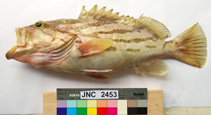| Family: |
Epinephelidae (Groupers) |
| Max. size: |
90 cm TL (male/unsexed); max.weight: 6,700.0 g |
| Environment: |
reef-associated; marine; depth range 80 - 370 m, non-migratory |
| Distribution: |
Indo-Pacific: Red Sea and East Africa to the central Pacific. Epinephelus poecilonotus, Epinephelus radiatus, and Epinephelus tuamotoensis are sometimes referred to as this species. |
| Diagnosis: |
Dorsal spines (total): 11-11; Dorsal soft rays (total): 14-15; Anal spines: 3-3; Anal soft rays: 7-8. Distinguished by the following characteristics: head and body tan, with dark brown bands: bifurcate band that begins at rear edge of eye, upper branch extending to a dark brown saddle blotch on the nape just in front of dorsal fin, lower branch running to lower opercular spine and continuing on body as midlateral band that bifurcates above the pectoral fin, upper branch of this band running to a dark blotch at the base of 3rd to 7th dorsal fin rays; dark band from the upper edge of the operculum to base of 5th to 9th dorsal fin spines; narrow band from lower edge of eye to pectoral fin base, continued as broken band along lower part of body and curving up to the dorsal part of peduncle; broad band from maxillary groove to posterior end of interopercle; small dark brown spots often present in the pale areas between bands; depth of body contained 2.8-3.1 times in SL; head length 2.3-2.5 times in SL; flat to moderately convex interorbital area, dorsal head profile slightly convex; shallow indentation on preopercle just above the enlarged serrae at the angle; upper edge of operculum almost straight; maxilla reaches to or past vertical at rear edge of eye; 2 rows of teeth on midlateral part of lower jaw (Ref. 89707). |
| Biology: |
Found in deep waters from 80-370 m on slopes of islands, sea mounts or continental shelves. Feeds on benthic fishes and large invertebrates (Ref. 89707). Considered rare in Tahiti but quite common in atolls (Ref. 4821). The species is easily confused with E. poecilonotus, E. radiatus, or E. tuamotuensis, three closely related deep-water groupers. Known to be ciguatoxic at Mauritius. Uncommon in local markets (probably due to it deep-water habitat). |
| IUCN Red List Status: |
Least Concern (LC); Date assessed: 22 November 2016 Ref. (130435)
|
| Threat to humans: |
reports of ciguatera poisoning |
| Country info: |
Museum: USNM 83847. Jolo Market, USNM 183847. Western Calatagan, Batangas, UPZM 5299. Also Ref. 393, 4768, 6956. |
Source and more info: www.fishbase.org. For personal, classroom, and other internal use only. Not for publication.

